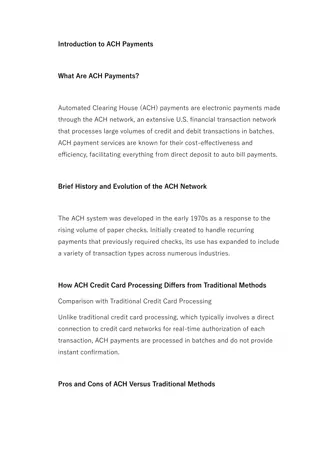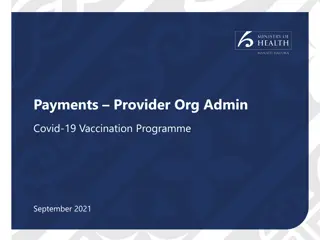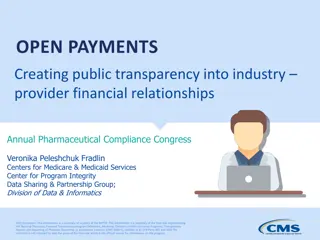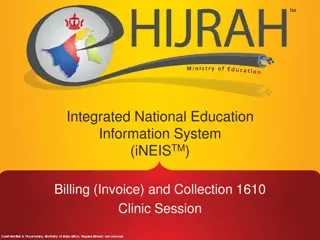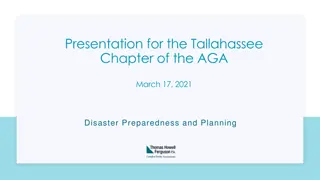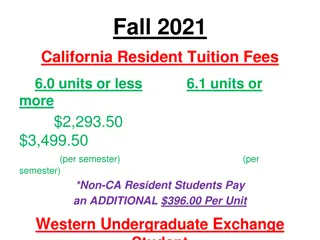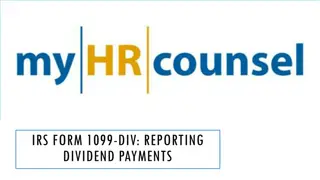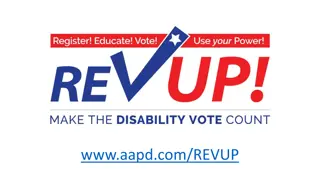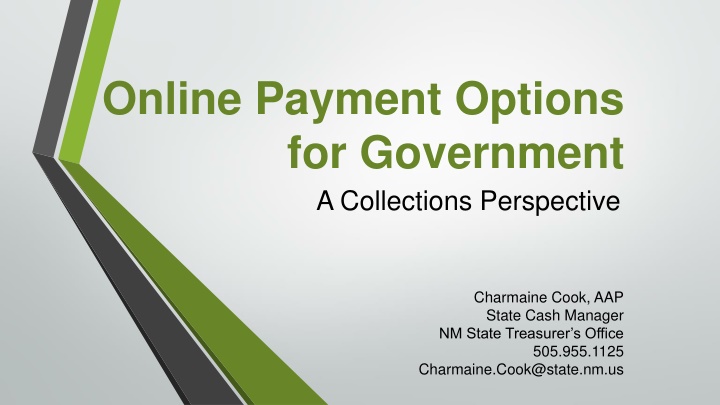
Optimizing Government Online Payment Options
Explore a comprehensive guide on online payment options for government collections, featuring insights on payment channels, cost comparisons, e-check payments, card payment fees, and more. Discover strategies to enhance payment processing efficiency and customer service.
Download Presentation

Please find below an Image/Link to download the presentation.
The content on the website is provided AS IS for your information and personal use only. It may not be sold, licensed, or shared on other websites without obtaining consent from the author. If you encounter any issues during the download, it is possible that the publisher has removed the file from their server.
You are allowed to download the files provided on this website for personal or commercial use, subject to the condition that they are used lawfully. All files are the property of their respective owners.
The content on the website is provided AS IS for your information and personal use only. It may not be sold, licensed, or shared on other websites without obtaining consent from the author.
E N D
Presentation Transcript
Online Payment Options for Government A Collections Perspective Charmaine Cook, AAP State Cash Manager NM State Treasurer s Office 505.955.1125 Charmaine.Cook@state.nm.us
Agenda Available online payment options Payment cost comparisons E-Check payments Fee options for card payments Formula for creating a card payment PCI DSS responsibilities Questions 2
Online Payment Channels 1. Credit/Debit Cards 2. E-Checks (ACH Debits) ACH Debits 3
Average Processing Cost - $100 Payment Check E-Check Credit/Debit Card $2.00 @ 2% (card present) $1.10 30 - 90 $2.50 @ 2.5% (card not present) Check Issuer (government entity) Merchant ACH Originator (government entity) Who Pays (government entity) OR cardholder 4
Average Processing Cost - $1000 Payment Check E-Check Credit/Debit Card $20.00 @ 2% (card present) $1.10 30 - 90 $25.00 @ 2.5% (card not present) Check Issuer (government entity) Merchant ACH Originator (government entity) Who Pays (government entity) OR cardholder 5
E-Check Payments Many online platforms provide Merchants the option to also offer E-Check payments Cardholder enters bank account # and bank routing #; their account is debited via ACH for payment Entering account information and initiating payment serves as authorization allowing Merchant to debit the account one time There are separate bank fees for E-Check payments; no service fee option; Merchant pays fees Good customer service payment option 6
Fee Options for Card Payments No Fee to Cardholder processing Convenience Fee processing VISA Service Fee processing 7
Fee Options for Card Payments No Fee to Cardholder Processing Cardholder initiates $100 payment $100.00 transaction created Convenience Fee Added Cardholder initiates $100 payment Convenience fee added (sample flat fee of $2.25) Total charges to Cardholder $100.00 transaction created $2.25 transaction created $102.25 total VISA Service Fee Added Cardholder initiates $100 payment Service fee added (sample of 2.5% fee used) Total charges to Cardholder $100.00 transaction created $2.50 transaction created $102.50 total 8
Convenience Fee Models Vendors offer Convenience Fee services with many flavors Allow merchants to designate a fee to cardholders to help offset the additional costs of accepting card payments No limitation on transaction types (MCC Codes) Convenience fee can be set as: A % of transaction, like 2% of payment amount, or A flat fee, such as $2.25 per transaction Funding from Convenience Fees may be credited to: Merchant services vendor to pay for card processing fees, or Merchant, who then pays fees to the vendor separately 9
VISA Service Fee Program For online payments only Program designated for governments and higher education only Limited set of transaction types (MCC Codes) are eligible Merchants sign a separate addenda to Merchant Services Agreement to participate Merchants are reviewed by VISA and accepted into program 10
VISA Service Fee Program (continued) Merchant accounts, called MIDs (Merchant ID) One MID created in Merchant name & tax ID for payments One MID in Financial Institution name & tax ID for service fees Merchant is not charged any fees for card payments made under Service Fee Program Service Fee is always a % of card transaction Service Fee % is determined by Financial Institution based on Merchant history; strategy is have the service fee cover cost of card transaction 11
Formula for Creating a Card Payment Merchant Acquirer Card Payment Processed Merchant Cardholder $$$ Government Entity Owner of the Debit/Credit Card Financial Institution with Settlement Relationships with VISA, MasterCard, Discover, American Express 1 Card Payment Processed 1 X 1 X = 1 12
Formula for Creating a Card Payment Card Payment Processed Merchant Service Providers Merchant Acquirer Merchant Cardholder Vendor A $$$ Vendor B Government Entity Owner of the Debit/Credit Card Financial Institution with Settlement Relationships with VISA, MasterCard, Discover, American Express 1 Card Payment Processed Vendor X, Y, Z Many variations and combinations of 1 X 1 X services are possibleX = 1 13
What is PCI DSS? PCI - Payment Card Industry and DSS Data Security Standards If you accept or process payment cards, the PCI Data Security Standards apply to you. PCI Security Standards Council The Council was founded in 2006 by American Express, Discover, JCB International, MasterCard and Visa Inc. They share equally in governance and execution of the Council's work. The PCI Security Standards Council touches the lives of hundreds of millions of people worldwide. A global organization, it maintains, evolves and promotes Payment Card Industry standards for the safety of cardholder data across the globe. https://www.pcisecuritystandards.org/pci_security/maintaining_payment_security 14
Determining Factors for PCI DSS In whose name are card transactions processed? Merchant name and Tax ID Government Entity is responsible Who touches cardholder data? Merchant, vendors, acquirer Who stores cardholder data? Hopefully not the merchant Does cardholder data pass through your system/network? 15
PCI DSS Prioritized Approach GOALS PCI DSS REQUIREMENTS Build and Maintain a Secure Network 1 Install and maintain a firewall configuration to protect cardholder data 2 Do not use vendor-supplied defaults for system passwords and other security parameters Protect Cardholder Data 3 Protect stored cardholder data 4 Encrypt transmission of cardholder data across open, public networks Maintain a Vulnerability Management Program 5 Use and regularly update anti-virus software or programs 6 Develop and maintain secure systems and applications Implement Strong Access Control Measures 7 Restrict access to cardholder data by business need-to-know 8 Assign a unique ID to each person with computer access 9 Restrict physical access to cardholder data Regularly Monitor and Test Networks 10 Track and monitor all access to network resources and cardholder data 11 Regularly test security systems and processes Maintain an Information Security Policy 12 Maintain a policy that addresses information security for employees and contractors 16
PCI DSS is not just for IT PCI DSS REQUIREMENTS 1 2 Install and maintain a firewall configuration to protect cardholder data Do not use vendor-supplied defaults for system passwords and other security parameters 3 4 Protect stored cardholder data Encrypt transmission of cardholder data across open, public networks 5 6 Use and regularly update anti-virus software or programs Develop and maintain secure systems and applications 7 Restrict access to cardholder data by business need-to-know 8 9 Assign a unique ID to each person with computer access Restrict physical access to cardholder data 10 11 Track and monitor all access to network resources and cardholder data Regularly test security systems and processes 12 Maintain a policy that addresses information security for employees and contractors 17





